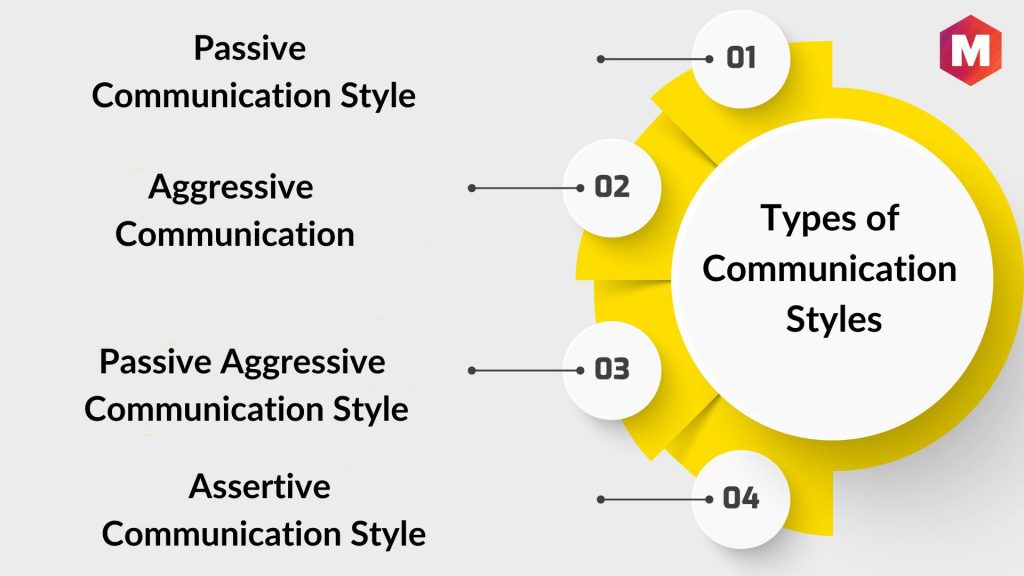Communication style is associated with the ways one says whatever he or she says.
Often, you would have seen people responding in the same manner how something is said to them- that manner is nothing but communication style, and while talking to someone, often the style matters more than the actual words.
Business leaders and managers who are well aware of different communication styles and capable of adapting their communications are more successful. This post will take you deep into the world of four different communication styles and their key features, so let us get started right away-
Table of Contents
What are Communication Styles?
Communication Styles are broad methods through which people tend to communicate with each other.
It helps in developing leadership traits by shaping a positive environment across the workplace and community. Learning different communication styles helps mold our words’ tone and content with different people to keep the conversation smooth and peaceful.
Importance of Communication Styles
One of the most important components for personal development and long-lasting building relationships is your communication style.
Different people have different manners of communicating due to diverse backgrounds, cultural differences, separate upbringings, and varied life experiences. The skill of dealing with varied conversations comes with effective communication techniques and the ability to socialize well.
People also experience breaking down of communication skills due to diverse patterns and habits in routine life. Learning effective communication skills becomes necessary because effective communication style and success are directly proportional to each other.
Moreover, connecting and socializing with people from diverse backgrounds helps in broadening the knowledge and mind.
Why Managers Should Know different Communication Styles?
As per their social style, employees describe an ideal manager’s characteristics in very different manners, which can help you understand how different styles are crucial in business management.
- Employees who are Drivers prefer their managers to be sincere and direct
- Employees who are Expressives like a manager who is open in communication, empathetic, friendly, and trusting
- Employees who are Amiables enjoy working with a manager who shows confidence in employees and is reliable and honest
- Employees who are Analytics like to work for managers who are knowledgeable and open in sharing information
That is why managers need to be aware of different styles and employees’ behavioral tendencies, and their approach towards employee interaction.
When managers are versatile and know the needs of many different communication styles well, they can solve the tasks and issues related to –
- Conflict
- Performance reviews
- Goal-setting
The Relation Between Communication Styles and Connections
Knowing different communication styles, one can feasibly socialize with others and build connections by conversing about relatable things and events.
Thus, learning communication styles is a prerequisite to develop bonds and connections, which is an essential aspect of life. The rationale for building connections in life are as follows:
- Stable interpersonal connections give out positive vibes that improve both mental and physical health.
- Good communication, manners, and connections aids in building a successful career.
- Efficacious communication styles and long-lasting bonds help in ensuring a familiar and healthy environment.
- People in relationships are less prone to depression and anxiety disorders.
Now, when you are well aware of the importance of different styles of communication, let us now go through the four communication styles…
Types of Communication Styles
Human beings develop several behavioral and non-behavioral characteristics during their lifetime, which usually become non-amendable or difficult to change.
But people shall learn all styles to connect with others feasibly and augment their base of thinking and conversating.
Following is the description of four types of communication styles which people must learn:
1. Passive Communication Style
Passive communication style is a communication style where one faces difficulty and hesitation in expressing their thoughts, feelings, and opinions and fails to identify their needs and safeguard their rights.
The inability to communicate and convey thoughts and emotions leads to miscommunication and misunderstandings, thus creating anger and frustration.
The common traits to identify passive communicator are difficulty making eye contact, poor posture, and failure to assert themselves. However, these people are the safest to share secrets with or any personal issues as they are compassionate and understanding.
2. Aggressive Communication
Aggressive communication styles is a manipulative communication style where individuals convey their feelings and thoughts dominantly and advocate their rights at others’ costs.
Aggressive communicator are usually rude, abusive, and cold-hearted. By dominating the conversations, aggressive communicators fail to listen to the problems of others.
Common features to recognize aggressive communicators are frequent interruptions in conversations, intense glaring, excessive condemning nature, and loud-mouthed. However, individuals with this conversational nature have many possible chances of becoming great leaders in the future as they can make others follow them.
3. Passive Aggressive Communication Style
Passive Aggressive communicators are those individuals who are passive in their real-life but have an untold resentment that they reveal in indirect ways to others. People of such nature feel stuck, confused, and become guilty of their mistakes.
Common traits to identify passive aggressive communicator are difficulty expressing their resentment, unusual muttering, and excessive sarcastic statements.
These individuals generally show those facial expressions that do not match what they are feeling or meant to say.
4. Assertive Communication Style
Assertive communication style is a type of communication style where individuals convey their feelings and thoughts to others and advocate for their rights without violating other people’s rights.
Assertive communicators care about their time and emotional needs and respect the problems and rights of others.
Traits to recognize assertive communicators are stating and pronouncing the words clearly and firmly, having a relaxed body posture, maintaining good eye contact, controlling emotions, having a calm tone of voice, and standing up for their rights. People of such nature often use ‘I’ statements to imply ownership, and they can deny other people politely.
It involves listening to others’ problems, having a compassionate nature, and developing a matured mindset by denying certain important aspects for personal development. People should develop an assertive communication style to develop an unbiased perspective and maintain and control the balance of emotions and work.
How to Improve Communication Style
To improve communication style in business or workplace, one needs to be aware of their own communication style (such as submissive communication style) and understand how it affects them and others around them. It is crucial for you to know about your listening skills, body language, tone, facial expressions and gestures as well as your ability to speak clearly without any distraction. You should also know about your verbal communication skills such as vocabulary, grammar, pronunciation etc.
You must learn how to use these skills effectively in order to make sure that the message reaches out to the person or group of people whom you are trying to communicate with. It’s important for you to know how other people perceive you so that you can adjust accordingly when needed.
For example: If someone says something wrong then they might not understand it until they hear it again from someone else who explains it better than them!
Communication skills also help us get things done faster because we don’t need to waste time explaining things over again when we can just explain it once and be done with it. Communication is a skill that everyone should have, whether you’re trying to impress someone or just get something done!
The Link Between Communication Style and Success
The ability to effectively communicate with others is one of the most important skills an employee can have, but it’s also one of the most difficult to master. In fact, according to research, only 25% of employees feel that they’re good at communicating—and just 2% think they’re great at it!
But communication skills are absolutely essential for success: they can help you get ahead in your career (and even land that dream job), make friends and build relationships, resolve conflicts between coworkers, the list goes on!
Here is a video by Marketing91 on Types of Communication Styles.
Conclusion
Communication styles play an important role in an individual’s self-development by improving communication skills, socializing well, building self-confidence, and respecting fellow individuals’ emotions and problems.
However, the assertive communication style is considered the best style, but one cannot deny the other three styles’ importance.
A workplace or a community shall contain diverse nature because a single dominant communication style would restrict discussions, lack of differences in opinions, and make the community or workplace monotonous with individuals having the same thoughts.
It would stop the process of learning and knowledge building.
Thus, one should respect individuals of any communication style and be compassionate towards their problems.
Are you aware of your communication style? What style of communication do you expect from your manager? Share your thoughts with us in the comment section below.
Liked this post? Check out the complete series on Communication




